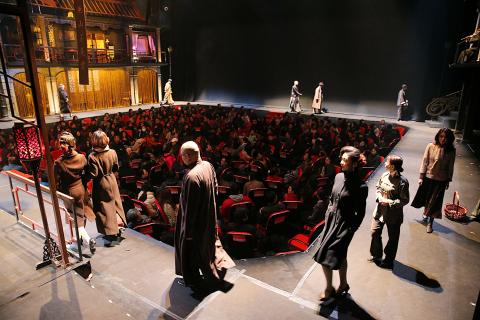Stan Lai’s (賴聲川) widely acclaimed A Dream Like A Dream (如夢之夢), a major landmark in Chinese-language theater, will take the stage at Taipei’s National Theater from Aug. 19 to Sept. 1.
First staged in Taiwan and Hong Kong in 2002, the epic eight-hour production has returned with a new cast, and features actors Chin Shih-chieh (金士傑), Hsu Yen-ling (徐堰鈴), Hu Ge (胡歌) and Chinese pop star Chris Lee (李宇春). Thirty actors will portray over 100 roles in the show. Oscar-winning designer Tim Yip (葉錦添) created the design for the 300-plus costumes.
Epic, romantic, extravagant, metaphysical and engrossing, Lai’s masterpiece will run for a total of eight shows. The production will have no subtitles.

Photo courtesy of Performance Workshop theater
“This story is about life and people’s choices,” Lai told the Taipei Times in an interview in June. “It’s essentially about karma.”
The plotline tells several interwoven stories with one leading to another. The narrative follows the life of Gu Shiang-lan, who lived through much of the 20th century, first as a prostitute in 1930s Shanghai and then, after marrying an aristocrat, a painter in Paris. Following the death of her husband, she returns to China in the 1950s and experiences the Cultural Revolution.
Lai said he drew on the Tibetan Book of the Dead, Tiananmen Square massacre and the Cultural Revolution to craft the emotionally complex story.
“The story moves ahead in time while referring to the past constantly, thus forming a unified whole,” Lai said.
To best present this complex story about love, life and enlightenment, Lai conceived a daunting 360-degree, two-story circular stage that surrounds the audience, who sit in the center pool section. Actors perform on the circular stage, sometimes with two or three actors for the same role appearing simultaneously.
“This story came to me organically, “ Lai said, adding that he thought up the story while attending a seminar in India in 1999. During a meditation session in front of the lotus tree where the Buddha is said to have attained enlightenment, the inspiration surged into Lai’s mind and he quickly scribbled down the plotline. “When you fall into the spell of this show, you won’t feel the length at all,” Lai said of the play’s length.
The performance is divided into two parts and scheduling allows audience members to watch it on two consecutive nights or both parts at the same time.

This month the government ordered a one-year block of Xiaohongshu (小紅書) or Rednote, a Chinese social media platform with more than 3 million users in Taiwan. The government pointed to widespread fraud activity on the platform, along with cybersecurity failures. Officials said that they had reached out to the company and asked it to change. However, they received no response. The pro-China parties, the Chinese Nationalist Party (KMT) and Taiwan People’s Party (TPP), immediately swung into action, denouncing the ban as an attack on free speech. This “free speech” claim was then echoed by the People’s Republic of China (PRC),

Exceptions to the rule are sometimes revealing. For a brief few years, there was an emerging ideological split between the Democratic Progressive Party (DPP) and Chinese Nationalist Party (KMT) that appeared to be pushing the DPP in a direction that would be considered more liberal, and the KMT more conservative. In the previous column, “The KMT-DPP’s bureaucrat-led developmental state” (Dec. 11, page 12), we examined how Taiwan’s democratic system developed, and how both the two main parties largely accepted a similar consensus on how Taiwan should be run domestically and did not split along the left-right lines more familiar in

As I finally slid into the warm embrace of the hot, clifftop pool, it was a serene moment of reflection. The sound of the river reflected off the cave walls, the white of our camping lights reflected off the dark, shimmering surface of the water, and I reflected on how fortunate I was to be here. After all, the beautiful walk through narrow canyons that had brought us here had been inaccessible for five years — and will be again soon. The day had started at the Huisun Forest Area (惠蓀林場), at the end of Nantou County Route 80, north and east

Specialty sandwiches loaded with the contents of an entire charcuterie board, overflowing with sauces, creams and all manner of creative add-ons, is perhaps one of the biggest global food trends of this year. From London to New York, lines form down the block for mortadella, burrata, pistachio and more stuffed between slices of fresh sourdough, rye or focaccia. To try the trend in Taipei, Munchies Mafia is for sure the spot — could this be the best sandwich in town? Carlos from Spain and Sergio from Mexico opened this spot just seven months ago. The two met working in the